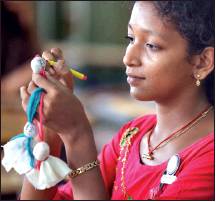Chekutty dolls
This is a collection of articles archived for the excellence of their content. |
As in 2019
Pradeep Thakur, June 8, 2019: The Times of India

From: Pradeep Thakur, June 8, 2019: The Times of India

From: Pradeep Thakur, June 8, 2019: The Times of India
Chekutty dolls from Kerala become global symbol of hope
Geneva:
When Ligi PK, a 48-yearold weaver in the small town of Chendamangalam in Kerala, is told that the stained piece of saree she is shaping into a doll is a global sensation of sorts, she is hardly surprised. Ligi has come a long way since August last year when devastating floods hit the southern state and wiped out houses and handloom machines in her town. She now makes over Rs 8,000 a month fashioning dolls out of handloom sarees sullied in the deluge, which she then puts in neat ready-to-be-shipped packages that will sell across India and beyond.
Thousands of such boxes recently landed at a United Nations conference on disaster risk reduction in Geneva after the World Bank placed an order for them. Several delegates at the meeting last month were seen carrying miniature handmade dolls, evoking much curiosity. But it wasn’t just the dolls’ exquisiteness that piqued everyone’s interest, it was also their story— and that of Kerala’s — screened twice in the form of a documentary at the conference that won hearts. The dolls, popularly known as Chekutty dolls, have quickly risen to prominence as the mascot of a new Kerala rebuilding itself.
Workshops where thousands of volunteers have learned how to make Chekutty dolls have been held in the USA, Australia, Brazil, France and Germany since the past year. Gopinath Parayil, who owns a travel company in Kerala and founded the Chekutty Initiative with designer Lakshmi Menon, said that 50,000 volunteers in nine countries have raised more than $120,000 until now from sale of the dolls. “Over 270 workshops on Chekutty-making have been held in various countries,” said Parayil.
Parayil said the money thus raised has been donated to the weavers’ society. A six-metre saree produces 360 dolls, priced at Rs 25 each. “While a saree sells for Rs 1,300 apiece, 360 dolls made from a single saree fetch Rs 9,000,” he said.
The idea to create the handmade dolls first struck Parayil when, after the floods, he saw weavers distraught as their stock of handloom sarees had been soiled by the water. “At that time, we had no idea the dolls would be such a hit.”
In fact, the enthusiastic response to the workshops has got an Australia-based travel company to roll out tours to Chendamangalam where one can learn the art of Chekutty from weavers firsthand. Reena Tory, who runs a travel company in Sydney, has held Chekutty workshops in Australian universities and said that the response was overwhelming. “I was in Kerala after the floods and was inspired by the stories of resilience and camaraderie in wake of the disaster. Chekutty came across as a reflection of this spirit. People were so curious about the story behind these dolls that we decided to organise tours to Chendamangalam.”
International institutions too have adopted these figurines and are using them to share a powerful narrative on how communities can overcome natural disasters. After showcasing the dolls at the conference by the United Nations Office for Disaster Risk Reduction (UNDRR) held from May 13-17, World Bank officials said the dolls may feature in their future conferences as well.
Chekutty dolls are now set to widen their global presence, with the UNAIDS (UN Programme on HIV/AIDS) also placing an order for thousands of dolls for an event at the UN General Assembly in New York this year.